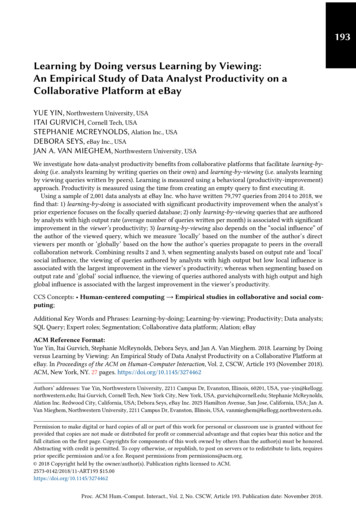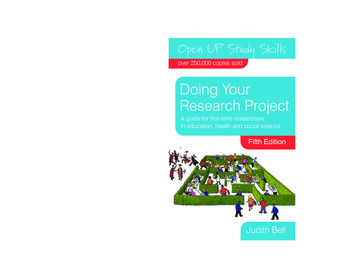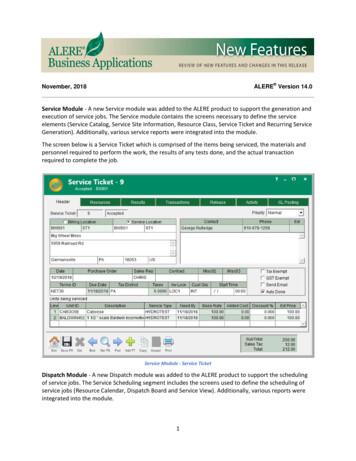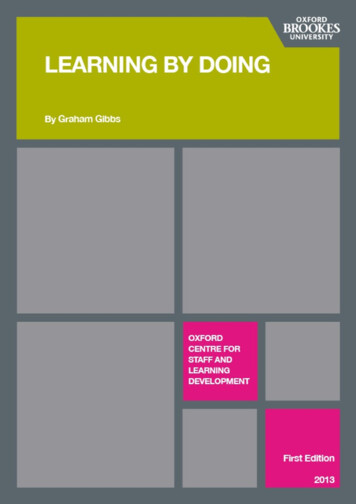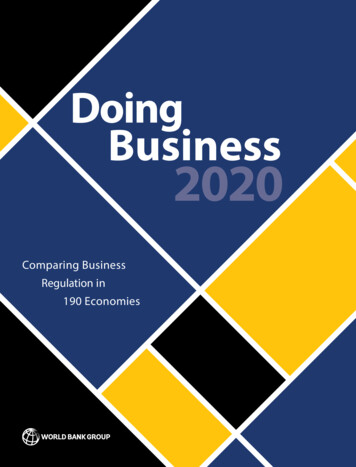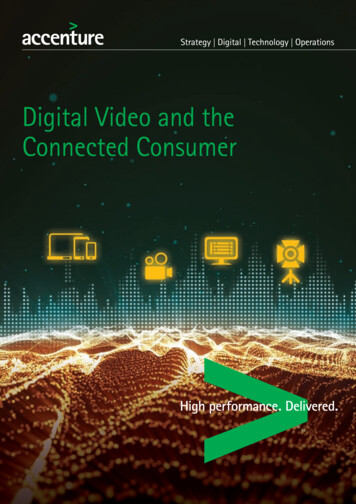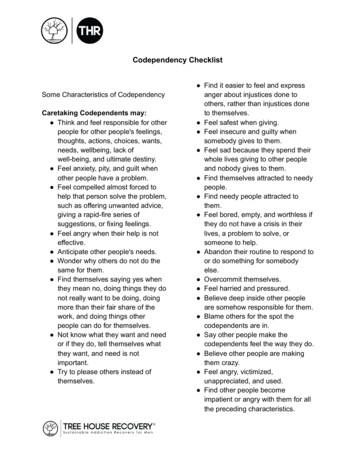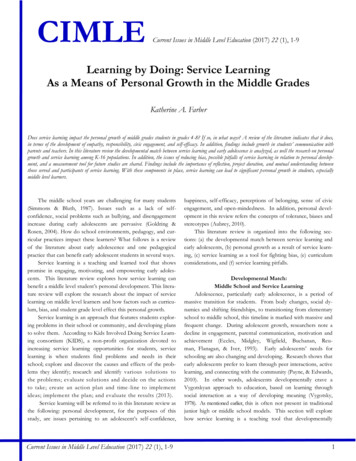
Transcription
CIMLECurrent Issues in Middle Level Education (2017) 22 (1), 1-9Learning by Doing: Service LearningAs a Means of Personal Growth in the Middle GradesKatherine A. FarberDoes service learning impact the personal growth of middle grades students in grades 4-8? If so, in what ways? A review of the literature indicates that it does,in terms of the development of empathy, responsibility, civic engagement, and self-efficacy. In addition, findings include growth in students’ communication withparents and teachers. In this literature review the developmental match between service learning and early adolescence is analyzed, as well the research on personalgrowth and service learning among K-16 populations. In addition, the issues of reducing bias, possible pitfalls of service learning in relation to personal development, and a measurement tool for future studies are shared. Findings include the importance of reflection, project duration, and mutual understanding betweenthose served and participants of service learning. With these components in place, service learning can lead to significant personal growth in students, especiallymiddle level learners.The middle school years are challenging for many students(Simmons & Bluth, 1987). Issues such as a lack of selfconfidence, social problems such as bullying, and disengagementincrease during early adolescents are pervasive (Goldring &Rosen, 2004). How do school environments, pedagogy, and curricular practices impact these learners? What follows is a reviewof the literature about early adolescence and one pedagogicalpractice that can benefit early adolescent students in several ways.Service learning is a teaching and learned tool that showspromise in engaging, motivating, and empowering early adolescents. This literature review explores how service learning canbenefit a middle level student’s personal development. This literature review will explore the research about the impact of servicelearning on middle level learners and how factors such as curriculum, bias, and student grade level effect this personal growth.Service learning is an approach that features students exploring problems in their school or community, and developing plansto solve them. According to Kids Involved Doing Service Learning consortium (KIDS), a non-profit organization devoted toincreasing service learning opportunities for students, servicelearning is when students find problems and needs in theirschool; explore and discover the causes and effects of the problems they identify; research and identify various solutions tothe problems; evaluate solutions and decide on the actionsto take; create an action plan and time-line to implementideas; implement the plan; and evaluate the results (2013).Service learning will be referred to in this literature review asthe following: personal development, for the purposes of thisstudy, are issues pertaining to an adolescent’s self-confidence,Current Issues in Middle Level Education (2017) 22 (1), 1-9happiness, self-efficacy, perceptions of belonging, sense of civicengagement, and open-mindedness. In addition, personal development in this review refers the concepts of tolerance, biases andstereotypes (Aubrey, 2010).This literature review is organized into the following sections: (a) the developmental match between service learning andearly adolescents, (b) personal growth as a result of service learning, (c) service learning as a tool for fighting bias, (e) curriculumconsiderations, and (f) service learning pitfalls.Developmental Match:Middle School and Service LearningAdolescence, particularly early adolescence, is a period ofmassive transition for students. From body changes, social dynamics and shifting friendships, to transitioning from elementaryschool to middle school, this timeline is marked with massive andfrequent change. During adolescent growth, researchers note adecline in engagement, parental communication, motivation andachievement (Eccles, Midgley, Wigfield, Buchanan, Reuman, Flanagan, & Iver, 1993). Early adolescents’ needs forschooling are also changing and developing. Research shows thatearly adolescents prefer to learn through peer interactions, activelearning, and connecting with the community (Payne, & Edwards,2010). In other words, adolescents developmentally crave aVygotskyan approach to education, based on learning throughsocial interaction as a way of developing meaning (Vygotsky,1978). As mentioned earlier, this is often not present in traditionaljunior high or middle school models. This section will explorehow service learning is a teaching tool that developmentally1
matches the needs of the early adolescent students and provideopportunities for enriched personal growth.The Importance of Ninth GradeResearchers have highlighted the importance of ninth gradein predicting a student’s chance of graduating from high school(McCallumore & Sparapani, 2010). Student success, according toresearchers, is directly linked to success in grade nine. Researchers have also explored how service learning in the ninth gradeyielded a strong correlation between student engagement and highschool graduation. During a K-12 School Based Learn and ServeGrant in two high needs schools in Illinois over a three year period, several service learning initiatives for ninth graders were developed (Sims, 2010). During these initiatives, researchers foundmany benefits, including increased social engagement, levels ofcivic responsibility, leadership development, and personal growth.Specifically in terms of personal growth, teachers reported anincrease in maturity and self-efficacy in students who participatedin this project (Sims, 2010).During the critical year of ninth grade, it is essential that students experience academic and personal success to increasechances of graduating from high school (McCallumore &Sparapani, 2010). Ninth grade serves as a transition from middleschool to high school. In the above service learning project, newninth grade students were aiding younger students transitioning tomiddle school as part of the service learning project. This heldreciprocal benefits for both parties (Sims, 2010). In other words,both the new middle school students and new high school students benefitted from participation in this service learning project.Ninth grade service learning projects are linked to greater academic success in ninth grade, which then increases graduation rates(Sims, 2010). In summation, ninth grade is a critical year for students to find academic success, and research suggests that servicelearning is one tool for students to achieve academically and growpersonally. Next, research about middle grade (sixth, seventh andeighth grades) students’, engagement, and high school rates isexplored.Middle School, Dropping Out, and Engagement.The middle grades are also critically important in terms ofstudent engagement and high school graduation rates. Whenstudents do not achieve academic success during the sixth grade,research shows they had poor attendance and a 10-20 % chanceof graduating high school on time (Payne, & Edwards, 2010).One of the primary reasons students dropped out was uninteresting classes (Farber, 2010). Middle level students are unique intheir pedagogical, socio-emotional, and personal needs, so relevant, authentic, and social learning experiences are needed to engage these learners (Eccles, Midgley, Wigfield, Buchanan, Reuman, Flanagan, & Iver, 1993). According to the National MiddleLevel Association, “With young adolescents, achieving academicsuccess is highly dependent on their other developmental needsCurrent Issues in Middle Level Education (2017) 22 (1), 1-9being met” (National Middle School Association, 2003, p.3). Inother words, middle school students’ cognitive, emotional, socialand physical needs were intertwined and impacted their engagement and motivation in school. According to Payne and Edward(2010), service learning is a way to re-engage learners in schooland put them on a path to successfully graduating from highschool.Middle School Service LearningLimited research was available for middle school/level service learning. Researchers determined that less than 9% of service learning projects are designed and implemented for middleschool students (Richards, Cornelli, Sanderson, Celio, Grant,Choi, George, & Deane, 2013). Researchers also made the developmental case for involving early adolescent students in servicelearning and pointed out several benefits of doing so (Billig,2011).One study of middle school service learning and academicsuccess compared three schools including a population of 1,153sixth through eighth grade students (Scales, Blyth, Berkas, &Kielsmeier, 2000). Researchers analyzed several features linkingthe development of adolescents to service learning. This studytested social responsibility, personal development, parental involvement, and engagement with school, perceived scholasticcompetence, responsibility, academic success, conduct, and mastery of goals. Key findings include increased personal growth ingroups that participated in longer durations of service learningprojects, and those who did a great deal of reflective work (Scales,Blyth, Berkas, & Kielsmeier, 2000). Students also reported thatparticipating in service learning encouraged them to become interested in other classes.Sixth grade females. The largest positive impact (includingparental communication and responsibility) on the middle schoolstudents was reported within the sixth grade female population(Scales, Blyth, Berkas, & Kielsmeier, 2000). These results connected to other research that demonstrated how service learningis impactful on middle school females (Eccles, Midgley, Wigfield,Buchanan, Reuman, Flanagan, & Iver, 1993). In that research,early developing females in grade six showed the most growth andbenefits from service learning. Often this group has particularsocial challenges, such as more difficulty with identity, and decreased teacher communication (Eccles, Midgley, Wigfield, Buchanan, Reuman, Flanagan, & Iver, 1993). Assisting these students with the transition from elementary school to middleschool, and childhood into adolescence could have long-termpositive results (Alspaugh, 1998) .Parental communication . Parental communication(between the child and parent) about school declines in the middle school years (Eccles & Harold, 1993). Communication between adolescents and their parents is important because involvement in school helps improve student academic success (Scales,Blyth, Berkas, & Kielsmeier, 2000). Middle level students had2
increased levels of parental communication after participating inservice learning projects. Therefore, service learning projects atthe middle level increase communication between students andparents, which in turn increase student achievement (Scales, Blyth,Berkas, & Kielsmeier, 2000).Sixth grade impacts. Research revealed that sixth gradershad the most increases in positive outcomes both personally andacademically from their participation in service learning (Scales,Blyth, Berkas, & Kielsmeier, 2000). The authors cautioned thatthis could be for several reasons other than their age and gradelevel, including the quality of the projects and gender norms andexpectations. Researchers call for more research to be done tosee which middle grade, if any, yielded the most positive outcomes from service learning. This is preliminary evidence thatservice learning is very impactful in the early middle grades, especially grade six (Scales, Blyth, Berkas, & Kielsmeier, 2000).This section provided a wide range of studies that supportthe use of service learning for many positive student outcomesincluding leadership skills, increased engagement and lessening ofdropping out, increased parental communication, and increasedself-efficacy. In addition, the research points to a developmentalmatch between the needs of early adolescents and the type oflearning and experiences service learning provides.Personal Growth in Middle Level StudentsPersonal growth can take many forms. There is not a universally accepted definition of personal growth, but in the context ofearly adolescents, scholar-practitioners can look for growth inempathy, perspective taking, leadership, interpersonal skills, reduced bias, increased confidence and connections with others(National Middle School Association, 2003).Reducing entitlement. The idea of limiting entitlement fitsnicely into the concept of personal growth and development. In astudy about college students, the researchers present a connectionbetween service learning and self-entitlement (Hoffman, & Wallach, 2007). They explore how colleges can reduce selfentitlement in students through participation in service learningprograms. Entitlement in this study was framed in terms of increasing personal responsibility and self-determination that leadsto the betterment of society. In other words, researchers note self-entitlement, or avoiding responsibility and having limited selfdetermination, as challenges for college students and as a challenge for future involvement in society and democracy (Hoffman,& Wallach, 2007). Key findings include college student participation in community service increases students’ perceptions of theimportance of volunteer work and significantly decreases selfentitlement attitudes. In a report about engagement and the purpose of the liberal arts in higher education, Hoffman, and Wallach(2007) noted:We believed that by engaging students, by involving them indemanding service-learning and community-based research expe-Current Issues in Middle Level Education (2017) 22 (1), 1-9riences, the academy could force them to consider their own privilege; challenge their assumptions of entitlement and selfindulgence; help them recognize that learning has implications foraction and use; help them develop skills and habits of resiliency;and make them aware of their responsibilities to the larger community (p.6).This is the case with service learning and entitlement(Hoffman, & Wallach, 2007) because outcomes include a shift inperception, from entitlement (blaming, expecting things to bedone for you) to being responsible for one’s own actions.Spirituality and life happiness. Further exploration of personal growth and service learning found connections to spirituality and life happiness. Louie-Badua and Wolf (2008) present theidea that service learning increases students’ spirituality. It is important to note that the authors define spirituality not as religiousper se, but as “one’s subjective awareness and internal values, withthe ability to explore the meaning and purpose of ourlives” (Louie-badua & Wolf, 2008, p. 91). They focus on threedimensions of service learning: interconnectedness; opening theheart to those around you, or removing “otherness;” and reflection that explores one’s background, values, purpose and meaning. These dimensions bring can bring lifetime commitment toserve others (Louie-Badua & Wolf, 2008, p. 91).This value and meaning also connects to studies of life happiness. Research on the effects of happiness and adult motivationhas been widely studied, but little is known about life satisfactionand happiness effecting education in K-12 students. In a study byLewis, Huebner, Malone, and Valois (2011), focused on how lifesatisfaction impacted student engagement in adolescents. Whenconsidering student engagement, personal factors such as a student’s emotional health and life satisfaction are important considerations. This is true especially in adolescence stages, when academic performance sags (Forrest, Bevans, Riley, Crespo, Louis,2013). Researchers found that middle school students who reported they were content with their lives at the beginning of theschool year were more likely to engage in their academic careerdespite their race, gender, socio-economic status, grade point average, and family status. This finding connects to Fredrickson’s(2001) Broaden and Build Theory of Positive Emotions. Fredricksonpostulates that students with higher life satisfaction are more successful in school. Researchers in the areas of life happiness andspirituality encourage school professionals to seek, monitor, andimprove cognitive engagement and life satisfaction in students(Louie-Badua & Wolf, 2008; Lewis, Huebner, Malone, & Valois,2011). Next, the benefits of service learning for all parties involved are explored.Reciprocal benefits of service learning. Reciprocity inservice learning has been noted by researchers (Jacoby, 1996; Vogel & Seifer, 2011). According to Vogel and Seifer, “Communityand university partners – including faculty members, students andcommunity organizations – are engaged as co-learners and co-3
creators of knowledge” (2011, p. 186). In other words, all partiesinvolved in service learning benefit from the experience. In onestudy researchers analyzed the outcomes of a service learningproject involving college freshman and elementary school students. They found reciprocal benefits for both the college andthe elementary students. The findings reveal that college studentswho participated in service learning expressed gains in selfesteem, coping strategies, and they volunteered more in theircommunities (Eppler, Ironsmith, Dingle, & Erickson, 2011).According to the study, elementary students showed gains in theirreading scores. Service learning projects designed around mentoring younger students can yield positive results for both parties,thus providing evidence that in-school leadership service learningcan be just as valuable as service learning in the community(Eppler, Ironsmith, Dingle, & Erickson, 2011).Positive relationships. Another aspect of personal growthis increased positive relationships with others. Carlisle (2011)focused on students who built positive relationships with teachers, other students and school staff in service learning experiences. Researchers recognize that adolescence is a period when students tend to disregard adult role models and focus on their peersinstead (Carlisle, 2011; Becker & Luthar, 2002). Problems thatmiddle school students face include bullying, teasing and exclusion (Goldenring & Rosen, 2004). These happen primarily duringunstructured times such as locker and lunch breaks. Researchershave studied how developing healthy relationships betweenteachers, schools staff and students, through participation in service learning projects, can combat some of these problems. Keyfindings include improvements in student behavior in terms oflessening bullying and office referrals, and an increase in studentsexpressing a need for healthy relationships (Carlisle, 2011).Student engagement. Student engagement has been mentioned in this literature review as it relates to school attendanceand graduation, but it is worthy of further exploration as it relatesto service learning. Educational researchers have studied variousways to define, categorize and label student engagement. Some ofthese are shared in this literature review, as a starting point inseeking connections between student engagement and servicelearning.According to Lewis, Huebner, Malone, and Valois(2011) student engagement is thought of as “a student’sdegree of active involvement in school through his or herthoughts, feelings, and actions” (p. 251). Maslow (1954)recognized that the emotional needs of individuals have tobe met before any other educational goals. Each day, students arrive in classrooms with varying degrees of availability for learning, engagement and personal development.Students’ cognitive engagement, especially in early adolescence, is linked to their socio-emotional needs (NationalMiddle School Association, 2003).When considering student engagement, Newmann stated,“Engagement is difficult to define operationally, but we know itCurrent Issues in Middle Level Education (2017) 22 (1), 1-9when we see it, and we know it when it is missing” (Newmann,1986, p. 242). In a comprehensive review about the definition ofstudent engagement, Zyngier (2008) revealed that it was mentioned in many studies and articles, but rarely defined. Many researchers have based their definitions on three distinct components of student engagement: cognitive, emotional, and behavioral(Murray, Mitchell, Gale, Edwards, & Zyngier, 2004; Smith, L.Butler-Kisber, L. LaRoque, J. Portelli, C. Shields, C. & Sparkes,2001). Cognitive engagement focuses on the achievement linkedacademic goals and participation within classrooms. Emotionalinvolves the feeling aspects of learning, discussion, and selfperception. Behavioral engagement is considered as positiveclassroom behaviors that support learning. These categories provide a solid framework for discussing engagement, but do notshare the whole picture. According to Zyngier’s (2008), anotherresearcher attempted to combine these realms into a participation/identification model, which equates engagement with academic success, based primarily on the individual, not consideringgender, socio-economic status, class and ethnic factors. Indeed,there are varying research opinions about whether engagement iseven linked to academic success.Similarly, Newmann isolated factors that constitute engagement in the following way, “(i) school membership (clarity ofpurpose, fairness, personal support, success and caring) and (ii)authentic work (extrinsic rewards, intrinsic interests, sense ofownership, connection to real world and fun” (Newmann, 1992,p.18). Zyngier (2008) noted recent research points to inclusiveclassroom environments, with greater parental involvement, andstudent empowerment in curriculum leads to increases in theabove listed factors. Additionally, he argued that student engagement must not be viewed in isolation, but must include school,teacher, and cultural contexts.The above mentioned contexts for learning (school, teacher,culture) are also very important in building strong service learningenvironments. Student leadership, voice and community involvement is linked to increased engagement, and these are fundamental aspects of service learning (Billig, 2011). Newman’s conceptsof school belonging and authentic work are linked directly to service learning. By involving students in all aspects of school andcommunity functioning and building an inclusive community, thisresearch on engagement supports a direct connection to the authentic, place based work of service learning.BiasAnalyzing one’s assumptions, biases and stereotypes can helpwith personal development. This is important educational workfor the classroom. Researchers believe that prejudices and stereotypes begin during the toddler years (Teaching Tolerance, 2014).These develop throughout childhood unless disrupted by individuals or experiences. Even biases that are thought to be extinguished can linger unless directly addressed. According to Gorski(2008), “Parents, teachers, faith leaders and other community4
leaders can help children question their values and beliefs andpoint out subtle stereotypes used by peers and in the media. Children should also be surrounded by cues that equality matters” (p.36). Just how might service learning challenge bias that mightexist or be developing in a middle level learner?Preservice teachers, bias, and service learning. This literature review will explore bias in terms of teachers, because it provides a window into how service learning can challenge existingbiases. One study focused on pre-service teachers who completed service learning projects with urban high school students. Researchers found that many of these pre-service teachers had stereotypical preconceived notions about urban, mostly minority youth(Conner, 2010). By working with this population through servicelearning, pre-service teacher’s biases are “unlearned.” In otherwords, preservice teachers dispelled their own assumptions abouturban youth based on direct interaction with them through service learning (Conner, 2010). Service learning opportunities mustbe complemented by student voice and reflection in order tobring about these changes. In addition, researchers found that theservice learning program must be well planned, high quality, andinvolve reflection and connections in the classroom to be impactful. If the experience is not of high quality and does not includethose tenants, then attitudes can remain unchanged or even become more negative (Erickson, 2009). Conner’s study (2010)features Contact theory, which shares five necessary conditionsfor attitude change (Allport, 1954). These conditions includeequal opportunities for contact; shared and common goals; groupcooperation; support of customs; cultures or law; and sustainedcontact (Allport, 1954). When these are present, researchers conclude, biases can be disrupted (Dovidio, Glick, & Rudman, 2005).In addition, the study also uses the theory of unlearning (Kohl,1994). This theory helps preservice teachers analyze their ownpreconceptions and language to see if it marginalizes oppressedpopulations. Both of these theories help provide insight abouthow biases can be challenged or unlearned through service learning experiences.The service learning outlined in Connor’s study (2010) willhave ramifications for thousands of students because their teachers will now begin their careers with fewer biases, stereotypes, andpreconceived notions about students from differing backgrounds.The research reflects the theme emerging in this review of theliterature, unlearning bias.Disrupting age bias in elementary students. A case studywas presented of a class of fourth grade elementary students whovisited a residential facility for the elderly as part of a long termservice learning project. Through repeated interactions, sharedexperiences, and reflection before, during and after the experience, the students’ perceptions of the elderly were transformed.The students reduced or eliminated biases about the elderly, developed a better understanding of elderly people, learned problemsolving skills and developed a sense of satisfaction from theirwork (Fair, Davis, & Fischer, 2011). In other words, studentsCurrent Issues in Middle Level Education (2017) 22 (1), 1-9began their service learning experience with biases and assumptions about the elderly. Researchers noted a marked change inthese perceptions during and after the service learning experience(Fair, Davis, & Fischer, 2011). This provides more evidence thatservice learning can help elementary and college student unlearnbiases.While there is a great need for more research in this area,studies indicate that service learning can be a tool to help studentsparticipate in an experience that can change their thinking aboutothers (Billig, 2011). As far as personal development is concerned, reducing bias in schools can yield significant benefits forthe school community and beyond. School violence, bullying,and exclusion usually have roots in biases, assumptions and stereotypes (Partners Against Hate, 2014). Therefore, it is critical thateducators explore meaningful ways to disrupt bias and providerepeated opportunities where students can broaden their thinking.Curriculum Integration ConsiderationsThroughout this literature review, the author has used wordssuch as “well developed” “carefully planned” and “thoughtfullydesigned” to describe service learning programs. Themes of reflection have surfaced through the research, but there is muchmore to service learning than reflection. The following sectionwill highlight the features of high quality service learning projects.Aspects of High Quality Service Learning ExperiencesBillig’s (2011) article, Making the most of your time: Implementingthe K-12 service- learning standards for quality practice, highlighted sixcomponents that create high quality service learning programs.These components include investigation, planning, action, reflection, demonstration, and celebration. Research about servicelearning demonstrates that these components (or similar ones) areneeded for service learning projects to be effective and yield positive results (Billig, 2011; Farber, 2010; Anderson & Hill, 2001).Billig (2011), shared several standards for high quality servicelearning that include the indicators in Table 1. See Table 1, page 6.Educators seeking the positive results of service learning canuse the components and the indicators of quality to shape theirprojects to have the most impact.Service learning integration examples. Public schoolshave integrated service learning into academic subjects in a waythat develops personal growth in students. Next, this literaturereview will explore several examples of service learning projectsthat were integrated into existing curriculum and studied by researchers for their outcomes.Literacy integration. Martin and Smolen (2010) describedhow service learning can be a vital part of a literature unit thatpromotes citizenship education and social justice. In a literatureunit highlighting the social justice struggles of the Irish potatofamine, students learned about the issue of hunger from personalnarratives in historical fiction. Students then continued this exploration byresearching hunger at the local and international level. During5
Table 1Standards and Indicators of Quality (Billig, 2011)StandardIndicators of QualityDuration and IntensityService learning projects have a long enough duration to participate in all the components, and to meet community needs andproject goals—usually several weeks or months.Meaningful ServiceProjects are age-appropriate and personally relevant. Processleads to attainable goals and increased understanding of societalissues.Links directly to curriculum and learning contentProjects have clearly articulated goals, are aligned with the curriculum, connect to other learning, and are supported by schoolboards.ReflectionService learning experience has regular reflection opportunitiesthat promote in-depth thinking about society, self, and servi
middle school as part of the service learning project. This held reciprocal benefits for both parties (Sims, 2010). In other words, both the new middle school students and new high school stu-dents benefitted from participation in this service learning project. Ninth grade service learning projects are linked to greater academ-
